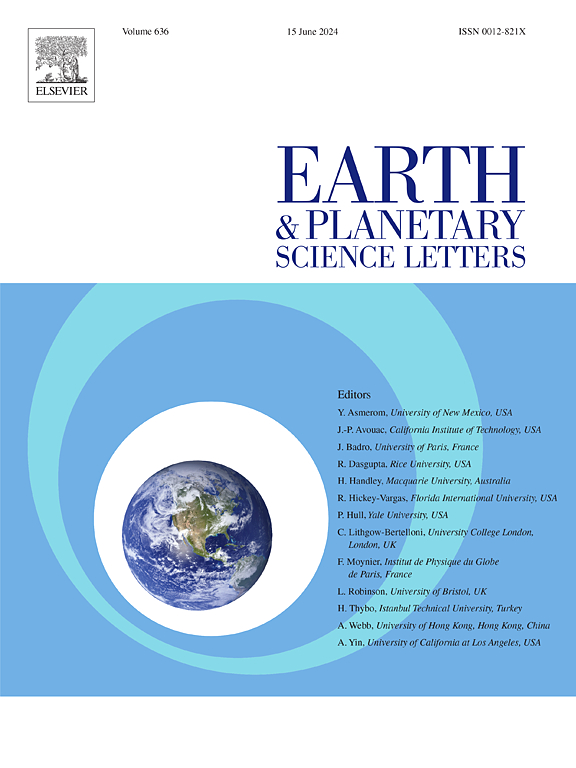彩虹热液区反应温度和压力以及传热和传质效率的地球化学制约因素
IF 4.8
1区 地球科学
Q1 GEOCHEMISTRY & GEOPHYSICS
引用次数: 0
摘要
大洋核心复合体(OCCs)所承载的海底喷口流体被认为是海水衍生热液沿深穿低角度剥离断层的循环。然而,对这类流体的源温度和压力的估算一直受到限制,因为地球化学方法通常要求喷口流体的二氧化硅浓度得到石英的缓冲,而在大洋核心复合体中,这种条件并不常见。在这里,我们扩展了Si-Cl地质温度计的计算方法,使其能够预测与任何硅缓冲矿物组合平衡的流体硅浓度,而不仅仅局限于石英。我们将这种方法应用于彩虹热液场喷口流体成分,发现它们与斜长石+方解石+绿泥石+透辉石矿物组合在(430 °C,359 bar)到(470 °C,468 bar)条件下的缓冲作用相一致,这相当于海底以下1.3-2.4千米的深度。这些估计值与彩虹地块内地震成像岩浆室的位置十分吻合。此外,通量和铁溶解度的计算也支持彩虹喷口流体相对较浅的起源,并意味着从海底提取热量和铁的效率相对较高。我们估计,彩虹喷口流体在上涌过程中只损失了 24-30% 的热量,几乎没有损失任何铁元素。与其他 OCC 托管的海底喷口相比,彩虹喷口流体的源区异常浅,这一观察结果与彩虹地块的地质解释相一致。二十多年来,彩虹热液田的喷口流体显示出明显稳定且高于海水的盐度。我们将这些喷口流体解释为来自较高盐度源流体的蒸汽,这种源流体是在岩浆注入和相分离的多个循环过程中形成的,而岩浆注入和相分离是沿着大洋扩张中心缓慢扩张的非火山段形成大洋地壳的固有过程。另外,较高盐度的源流体可能来自与超基性岩蛇绿岩化有关的矿物水化反应。因此,正如几个已知的例子(包括TAG、Kairei和Edmond喷口区)所表明的那样,预计出现高于海水盐度的喷口流体是OCC托管喷口区的一个共同特征。本文章由计算机程序翻译,如有差异,请以英文原文为准。
Geochemical constraints on reaction temperature and pressure and heat- and mass-transfer efficiency at Rainbow Hydrothermal Field
Seafloor vent fluids hosted by oceanic core complexes (OCCs) are thought to represent circulation of seawater-derived hydrothermal fluid along deeply penetrating, low-angle detachment faults. However, estimation of the source temperatures and pressures of such fluids has been limited because geochemical methods typically require vent fluid silica concentrations to be buffered by quartz, a condition not often met at oceanic core complexes. Here, we extend the calculation of the Si-Cl geothermobarometer to enable predictions of fluid Si concentrations in equilibrium with any Si-buffering mineral assemblage, rather than being restricted to quartz. We apply this method to Rainbow Hydrothermal Field vent fluid compositions and find that they are consistent with buffering by a plagioclase+talc+chlorite+tremolite mineral assemblage at conditions ranging from (430 °C, 359 bar) to (470 °C, 468 bar), which correspond to depths of 1.3–2.4 km below the seafloor. These estimates agree well with the locations of seismically imaged magma chambers within the Rainbow Massif. Additionally, calculations of fluxibility and Fe solubility support this relatively shallow origin for Rainbow vent fluids and imply relatively efficient heat and Fe extraction from the seafloor. We estimate that only 24–30 % of the heat content and almost no Fe is lost during upflow of Rainbow vent fluids.
Compared to other OCC-hosted seafloor vents, the source region of Rainbow vent fluids is anomalously shallow, an observation consistent with geological interpretations of the Rainbow Massif. Vent fluids at Rainbow Hydrothermal Field have exhibited apparently stable and greater-than-seawater salinity for over two decades. We interpret these vent fluids as vapors derived from a higher-salinity source fluid that developed over multiple cycles of magma injection and phase-separation inherent to the formation of oceanic crust along slow-spreading, non-volcanic segments of oceanic spreading centers. Alternatively, higher-salinity source fluids could be derived from mineral hydration reactions associated with serpentinization of ultramafic rocks. The occurrence of greater-than-seawater salinity vent fluids is thus predicted to be a common feature of OCC-hosted vent fields, as indicated by several known examples, including the TAG, Kairei, and Edmond vent fields.
求助全文
通过发布文献求助,成功后即可免费获取论文全文。
去求助
来源期刊

Earth and Planetary Science Letters
地学-地球化学与地球物理
CiteScore
10.30
自引率
5.70%
发文量
475
审稿时长
2.8 months
期刊介绍:
Earth and Planetary Science Letters (EPSL) is a leading journal for researchers across the entire Earth and planetary sciences community. It publishes concise, exciting, high-impact articles ("Letters") of broad interest. Its focus is on physical and chemical processes, the evolution and general properties of the Earth and planets - from their deep interiors to their atmospheres. EPSL also includes a Frontiers section, featuring invited high-profile synthesis articles by leading experts on timely topics to bring cutting-edge research to the wider community.
 求助内容:
求助内容: 应助结果提醒方式:
应助结果提醒方式:


